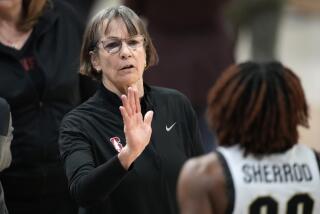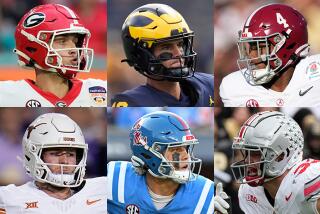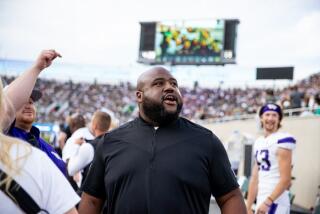COLLEGE FOOTBALL BOWL GAMES : TOP CATS : You Didn’t Have to Score 1,037 on SAT to Understand That Northwestern’s Turnaround This Season Was Huge
- Share via
The day before before its season opener against Notre Dame, Northwestern’s football team visited the College Football Hall of Fame.
Little did the Wildcats know they might end up in the Hall of Fame for pulling off perhaps the biggest overnight transformation in college football history, rising from the depths of the Big Ten to the conference championship and the No. 3 ranking in the nation.
The Wildcats’ improvement from 3-7-1 to 10-1 in one dizzying season is not the greatest statistical leap in NCAA records, or even the biggest recorded in their conference. But no team that reversed course so quickly was burdened with the wretched reputation Northwestern earned over 23 consecutive losing seasons, including a 34-game losing streak from 1979 into 1982.
Nor did other schools turn their programs around while under the constraints Northwestern faces as a relatively small, private university that maintains lofty academic standards and counts among its alumni one current Supreme Court justice (John Paul Stevens) but no Heisman Trophy winners. The average Scholastic Assessment Test score of incoming freshman football players the four years before this season was 1,037, higher than any Division I-A program other than Stanford, and a total that almost equals the number of points Northwestern gave up during its epic losing streak (1,370).
“For so many years now, when you’d think of doormats in college football, Northwestern has been at the top of the list,” said Sean McDonough, a play-by-play announcer on CBS’ college football telecasts and the radio voice of Boston College games. “For them to turn it around in such a short period of time, to go 10-1, win the Big Ten title and go to the Rose Bowl, it may be the greatest team story in our country in 1995 in any sport.”
Said Ara Parseghian, who coached Northwestern from 1956 to 1963 before leaving for Notre Dame: “It’s the achievement not only of the decade, but probably of the century. Fantastic is the word I’ve used when anyone has asked me about it.”
NCAA records show the biggest one-season turnaround was eight games. That was accomplished by Stanford, which went from 1-7-1 in 1939 to 10-0 in 1940, and duplicated by Purdue, which was 1-8 in 1942 and 10-0 in 1943. To calculate the improvement from one season to the next, take the difference in victories and divide by two, the difference in losses and divide that by two, and add the two figures. Ties are ignored.
Ten schools have improved by 6 1/2 games or more. Most recently, Tulsa went from 3-8 in 1990 to 10-2 in 1991. A victory over USC in the Rose Bowl would give the Wildcats an 11-1 record and make them the 10th team in NCAA history to improve its previous record by seven games or more. That last occurred in 1986, when San Jose State soared from 2-8-1 to 10-2.
“Historically speaking, the one thing that always sticks out in people’s minds is Stanford,” said Kent Stephens, collections manager at the College Football Hall of Fame. “Up until then, college football teams played a single-wing formation. Then Clark Shaughnessy came in as coach and they started playing a T-formation.
“No one else had used that formation before, so it blew people away that that would even work. Pop Warner said, ‘If that formation works, you can take everything I know about football and throw it into the Pacific Ocean.’ ”
Because the ’95 Wildcats didn’t have an innovation to befuddle opponents and because they so decisively broke a losing tradition, Stephens ranks their feat ahead of the 1940 Stanford squad’s. He also discounts Purdue’s 1943 performance because Purdue became an officer training center for the Navy and Marines during World War II and was stocked with players who had played for other schools.
“Stanford has not been a perennially bad team. They had great teams in the ‘30s, whereas Northwestern had a run of close to 30 years where they weren’t very good,” Stephens said. “I can’t think of someone that was a perennial loser and made this kind of dramatic improvement.”
Until this season, Northwestern was 8-24-1 under Coach Gary Barnett and hadn’t had a winning record since 1971. From 1972 through ‘94, the Wildcats had two All-Americans, but eight Academic All-Americans. Twenty Wildcats were named All-Big Ten in those 23 seasons; 100 made the Academic All-Big Ten team. This season, linebacker Pat Fitzgerald was an All-American and six players were voted to the media’s all-conference team. Barnett was named coach of the year by 10 major publications or organizations.
“Part of the charm of the story is that it’s not just any school, it’s a school where, after you graduate, you go on to do impressive things in life after college football,” McDonough said. “It restores your faith in college football, much like Duke did in basketball with true student-athletes.”
NCAA records are dotted with college football programs that made big turnarounds, though not quite as rapidly as Northwestern did.
Syracuse was 5-6 in 1986 and leaped to 11-0-1 in 1987 under Coach Dick McPherson. Wisconsin was 5-6 in 1992 before a 10-1-1 season in 1993 in which the Badgers played in their first Rose Bowl since 1963.
The emergence of nontraditional football schools can be attributed in part to the NCAA having leveled the playing field a bit by limiting scholarships to 85 per school. Talented kids who might have sat on the bench at a football factory may go elsewhere, strengthening those teams.
But as Parseghian points out, that doesn’t completely explain Northwestern’s success. “You start with the outstanding ability of Barnett and his ability to change the attitude, a good staff and some good players and some help from the NCAA,” Parseghian said. “[The effect of the scholarship limit] took a little while to develop. I am not qualified to say what percent should be given to each factor but it’s clearly a remarkable achievement.”
Barnett was part of a transformation at Colorado as an assistant to Coach Bill McCartney. The Buffaloes climbed from 1-10 in 1984 to 7-4, 6-5, 7-4 and 8-3 before going 11-0 and winning the national championship in 1990. “That was gradual,” Barnett said. “This one is a little more dramatic.”
More than a little. “I think what they’ve done is fantastic,” McPherson said. “If some team rose out of the blue and became a Rose Bowl contender and bent the rules, that would be one thing. They knew the rules and they stayed within the rules. That’s why everybody’s happy. Nobody’s embarrassed by it.”
ABC’s Keith Jackson, the play-by-play announcer for the Wildcats’ 21-10 victory over Penn State Nov. 4, has his own way of gauging Northwestern’s renaissance. “The last time I was in Dyche Stadium prior to this season was 1958,” Jackson said. “So that gives you some measure of its significance.”
However, he hesitated to join those who call Northwestern’s turnaround the sport’s greatest metamorphosis. “It might well be overstated a bit,” he said. “Teams have gone 1-10 to 9-2 before. Northwestern has, in certain times, had decent teams. Ara Parseghian had winning programs. Alex Agase [Northwestern’s coach from 1964-72] had some winning teams [1970-71]. Francis Peay [who was 13-51-2 as coach from 1986-91] came close but had bad luck. There were instances where they had injuries and lacked manpower. . . .
“I tend to think the academic requirements are a tad overstated because Stanford has been to the Rose Bowl and you can’t say the academic requirements at Stanford are any easier.”
Parseghian disagrees. “This is an incredible achievement because they still have high academic achievements and high costs. At least that’s what we combated,” said Parseghian, who was 36-35-1 at Northwestern.
“I can’t tell you the number of calls I got in the last two decades saying, ‘Northwestern should get out of the Big Ten.’ I’d say, ‘No, geographically they’re in the proper spot, and where would they go? They could be a .500 team.’
“I always said they should have .500 seasons and once in a while have a big year. By ‘big year’ I mean 9-2, 8-3. This has surpassed anything I would have envisioned because of the handicaps a coach there is under.”
McPherson said the true test of the Wildcats’ accomplishment is whether they become perennially successful, as Brigham Young became in the 1970s after Coach LaVell Edwards turned the program around. “The key is not to win once but to maintain that,” McPherson said. “The great ones have, like Joe Paterno at Penn State and Tom Osborne at Nebraska. For Gary to get his program to be one of the great ones he’d have to do that.”
Parseghian thinks Northwestern has met the qualifications for greatness. “There were 10 other schools in the Big Ten trying to achieve what Northwestern did and they couldn’t,” he said.
“Has this gotten the program turned around to the point where they can be as consistent as Penn State or Ohio State or Michigan? That’s not the question here. Have all of the problems created for Barnett gone away? I don’t know, but they cannot take away what they’ve done. They did it against Joe Paterno. They beat Michigan at Michigan, they beat Wisconsin and they beat Illinois. I don’t care how it happened, but it happened.”
More to Read
Go beyond the scoreboard
Get the latest on L.A.'s teams in the daily Sports Report newsletter.
You may occasionally receive promotional content from the Los Angeles Times.











